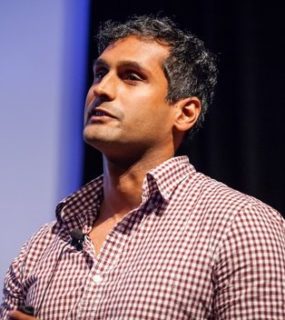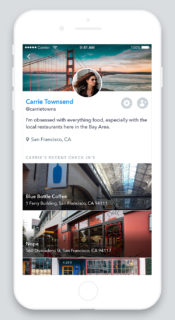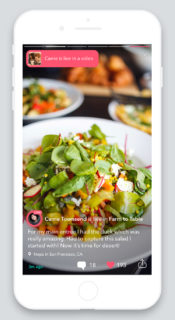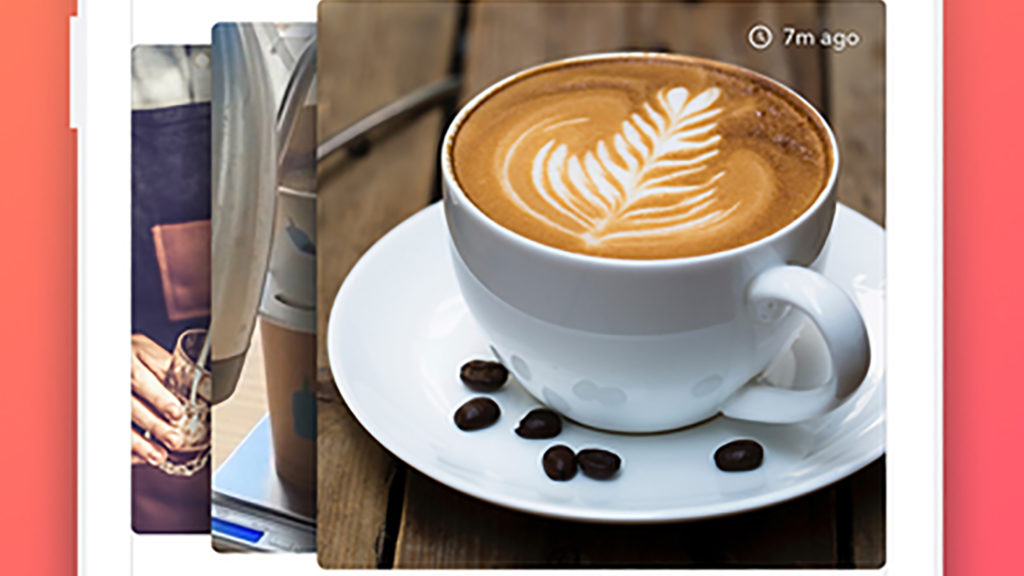Nom is a food-focusing livestreaming social platform founded by former YouTube CTO, Steve Chen and former YouTube engineering lead, Vijay Karunamurthy. Chen helped create YouTube and Karunamurthy worked for many years building the team that worked on the user experience. One of the things the two found most inspiring about YouTube was how the platform helped connect people and gave them a means of expressing themselves in new ways, ultimately building a new category of creators.
After YouTube, Chen and Karunamurthy moved to Google Ventures, where they were brainstorming startup ideas. It was in a café at Google, where a new chef was brought in every month, that the concept for Nom came into being. They were more interested in talking about the food, ingredients and what they were going to eat than startup tech ideas.
“I think there’s a new energy around food and cooking for a young audience,” Vijay Karunamurthy, now CEO of Nom, explained to [a]listdaily. “It’s kind of a new world of exploring different cultures, different stories and different parts of people’s lives through the world of food and cooking.”
To make Nom come to life, they first had to think about mobile devices and how people relate to video on them. “It’s important to connect what people do when they’re on a smartphone with what they want to do in real-life,” said Karunamurthy. “By the fact that you’re interested in a cappuccino video and photos shared by a barista around the corner, we might be able to suggest to you a great coffee bar here or in Tokyo (if you’re traveling out there) and encourage you to go out and explore things on your own.”
The app, which launches today, recommends content by learning the user’s tastes through the types of ingredients, recipes and restaurants they swipe on. If a user selects a lot of vegan or vegetarian recipes, the app is not likely to recommend a charcuterie place. The aim is to connect users with great food that’s relevant to them, which could include everything from local restaurants to eateries in other countries, using photos, video clips, and livestreaming videos featuring food lovers talking about what they’re excited about.
In addition to restaurant discovery, Nom can also provide tips around the kitchen using special ingredients. A passionate community, with its own language and rhythms, is also a very important aspect to the platform. So, Nom will have professional chefs share recipes or give behind-the-scenes looks at their kitchens. The platform has partnered with ABC’s The Chew and Vice Munchies in addition to DIY food bloggers to engage with the community by answering questions about ingredient substitutions and more.
Karunamurthy talked in-depth with [a]listdaily about how Nom could become a powerful and engaging platform for the food community.

How does Nom differ from existing food-themed apps and communities on Facebook, Twitch and YouTube?
It doesn’t much resemble a lot of food apps, where we see a lot of text recipes or text reviews of restaurants. When you go out, we hope that you share a couple photos, a video clip, and really engage with the audience rather than writing a review of the restaurant.
It relates to how people want to communicate today. People use social media to share a beautifully crafted photo of a dish that they made last night. Our hope is that we give you a way to express yourself through stories in a way that you bring the audience into the act of making a meal or eating out at a restaurant. What I mean by that is that you can see the art of creation or go behind-the-scenes of what chefs do in a new way that existing social media platforms aren’t really built for.
How is Nom using influencers to grow the community?
One of the things that got us excited about food and cooking is the huge diversity of voices you can find. We’ve got content from influencers who know the best coffee shops in San Francisco, and hearing their voices on video is pretty special because some of these people have built huge followings across other social media channels, but they’ve never had that one-on-one connection with audiences.
We also have top-tier Michelin star chefs—folks like Corey Lee at Benu, the first Michelin three-star restaurant in San Francisco. And Timothy Hollingsworth in LA; he opened Otium after working at French Laundry for many years and has a cool perspective on the Downtown LA food scene and everything being revitalized around there. Being able to share their voices as top-tier chefs is very important to us and it relates to the content we’re getting from ABC Disney and other media partners with their celebrity chefs. There’s a huge range of how those experiences are shared and what you expect to see from either a rock star celebrity chef or one that just opened an amazing restaurant around the corner from you. Having that full range of content is very important.
Were you inspired by the growing popularity of Korean muk-bang videos?
The muk-bang videos in Korea are super popular now, and we have an investor—Psy from the Gangnam Style video. He has a strong background in cooking in Korea because his grandmother owned a chain of noodle shops there. He can walk into a restaurant in Koreatown in LA and order a whole bunch of fishes, pickles and other ingredients to make his own noodle dishes at the table. So, we’re excited to have him advise us on how we can share that celebrity angle of how food and cooking can connect with the audience.
Sometimes, people want to have as much fun watching a food video as they want to learn something. We’ve been thinking about that as we approach the angle of educating and entertaining at the same time—sharing a few clips from Psy and photos of ingredients that go into a recipe. I think the muk-bang videos are an interesting social angle, where people want to connect over the food they’re eating. Sometimes just viewing someone livestream eating is enough to spark that connection.
 Will Nom remain exclusive to mobile devices, or is there consideration being given to platforms like desktop computers, Roku or Amazon Fire TV?
Will Nom remain exclusive to mobile devices, or is there consideration being given to platforms like desktop computers, Roku or Amazon Fire TV?
There’s something special about mobile, where you have the phone in front of you and get an immersive, engaging experience. You have to accommodate short attention spans, so you don’t have ten- or twenty-minute long videos. But you can also connect with people who are out and about and doing things. If someone is viewing a restaurant video, we want to provide a chance for them to book a table at that restaurant, and get people out there doing things. That’s a special opportunity when you’re on mobile, and we think that’s what everyone is trying to figure out right now. They’re trying to figure out the right format for video, live video and engagement. We think the community angle of food and cooking ties it all together.
We’re looking at other platforms in the future, but we’re focusing on mobile right now. A Roku or Apple TV could be a very different mindset or environment for how you want to think about video—when you’re on your couch as opposed to being in your kitchen.
How did The Chew and Vice Munchies become involved with Nom?
One of the things we wanted to figure out, launching this week, is: who are the people who have figured out the right format for storytelling and content? Because they’re connecting with the audience already. Both The Chew and Vice connect with a huge audience right now.
With The Chew, if you go to a live taping, the audience members get really into being there with Mario and Carla, and they interact with the audience behind-the-scenes as they go along. We wanted to bring that energy to the mobile audience by showing what’s happening in the middle of filming, or more about the recipe.
Vice Munchies has a global perspective on the world of food and cooking. They’ve reached the millennial audience by focusing on human stories of these chefs and ingredients like king crab in Asia. Getting a different perspective, seeing upcoming shows, and behind-the-scenes clips are important for us because they capture the social energy around food.
 Are you going to integrate brand sponsorships into some of the content?
Are you going to integrate brand sponsorships into some of the content?
One of the things that was special about YouTube, from the very early days, is that we focused more on the user experience than we did on advertising. I think that YouTube has the global impact that it has today because of that relentless focus on a great user experience and encouraging users to create more great content—even while other folks were thinking about advertising earlier than us.
With Nom, we think there are opportunities but also huge challenges for advertising with the community and live engagement. We don’t want to get in the way of a great user experience. So, for the time being, you’re not seeing any advertising on there. What we want to do is connect people with what they want to do in real-life. So, if we know you’re chatting about a restaurant in the app, we want to suggest booking a table there. If you’re chatting about a Sicilian pasta recipe, we can suggest having pasta delivered to you.
Connections are more important to us than trying to just make money or revenue off advertising because they help you, as a user, do things that you wouldn’t be able to do if you didn’t know about them.
What do you think it is about food and eating that relates so well with social connection?
Two things. One is how food is a universal passion for people. A lot of people spend their lunch break thinking about what they’re going to get for dinner. When shopping for groceries, they think about fun new recipes they could try. There’s a renewed focus on how food is a fun, interesting, exciting and social part of people’s lives that we’re excited to tap into.
Second is that it’s something that everyone can appreciate and do. A lot of people who watch music videos might not necessarily know how to play a guitar, but people can watch a recipe video or see a dish at a restaurant and try it out at home. It has become a very participatory way for people to express themselves. We’re excited about this angle of the community, where it’s more than just passively watching—it’s doing things. That creates a new category of creators, how people connect over mobile video, and a new way of thinking about live video.

